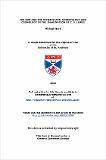Files in this item
The Son and the other stars: Christology and cosmology in the imagination of C.S. Lewis
Item metadata
| dc.contributor.advisor | Begbie, Jeremy | |
| dc.contributor.advisor | Hart, Trevor A. | |
| dc.contributor.author | Ward, Michael | |
| dc.coverage.spatial | 297 | en_US |
| dc.date.accessioned | 2012-06-14T15:13:03Z | |
| dc.date.available | 2012-06-14T15:13:03Z | |
| dc.date.issued | 2005 | |
| dc.identifier | uk.bl.ethos.552695 | |
| dc.identifier.uri | https://hdl.handle.net/10023/2783 | |
| dc.description.abstract | This dissertation treats the theory and practice of C. S. Lewis's theological imagination, focussing upon the imaginative use he made of his professional expertise in medieval and renaissance literature. Its approach is principally expository rather than an evaluative. Chapter One outlines the centrality of the imagination to a proper understanding of Lewis's works. Chapter Two examines Lewis's own theory of imagination and surveys how he practised it as a literary critic. We compare and contrast Lewis's theory and practice of imagination with that of his friend, the theologian, Austin Faffer. Chapter Three looks in more detail at Lewis's imaginative practice, in particular his fascination with the images supplied by the seven planets of the Ptolemaic cosmos, which he termed 'spiritual symbols of permanent value'. We analyse what he meant by 'sprit' and 'symbol'. Chapter Four introduces the main argument of the dissertation namely that these seven spiritual symbols structure the works for which Lewis is best known, the seven 'Chronicles of Narnia'. We claim to have uncovered the governing imaginative blueprint of the septet. We address Lewis's capacity for and interest in secrecy and consider why this planetary theme has remained hitherto undetected. In Chapters Five to Eleven we take the seven planets in turn and trace the use Lewis made of them through out his writings. We analyse the planetary symbolism undergirding each Chronicle and conclude each chapter with an exegesis of the Christological message of each book so understood. Chapter Twelve examines factors which motivated Lewis to focus his imaginative energies upon Ptolemaic cosmology and suggests one particular occasioning factor behind the composition of the Chronicles. In addition, we consider theological and pedagogical reasons why he kept silent about the planetary theme. We conclude by indicating certain consequences that our argument has for future readings of these seven works. | en_US |
| dc.language.iso | en | en_US |
| dc.publisher | University of St Andrews | |
| dc.rights | Creative Commons Attribution-NonCommercial-NoDerivs 3.0 Unported | |
| dc.rights.uri | http://creativecommons.org/licenses/by-nc-nd/3.0/ | |
| dc.subject.lcc | PR6023.E90Z5W27 | |
| dc.subject.lcsh | Lewis, C. S. (Clive Staples), 1898-1963--Religion | en_US |
| dc.subject.lcsh | Lewis, C. S. (Clive Staples), 1898-1963. Chronicles of Narnia | en_US |
| dc.subject.lcsh | Jesus Christ--In literature | en_US |
| dc.subject.lcsh | Cosmology, Ancient, in literature | en_US |
| dc.subject.lcsh | Planets in literature | en_US |
| dc.title | The Son and the other stars: Christology and cosmology in the imagination of C.S. Lewis | en_US |
| dc.type | Thesis | en_US |
| dc.type.qualificationlevel | Doctoral | en_US |
| dc.type.qualificationname | PhD Doctor of Philosophy | en_US |
| dc.publisher.institution | The University of St Andrews | en_US |
This item appears in the following Collection(s)
Except where otherwise noted within the work, this item's licence for re-use is described as Creative Commons Attribution-NonCommercial-NoDerivs 3.0 Unported
Items in the St Andrews Research Repository are protected by copyright, with all rights reserved, unless otherwise indicated.


